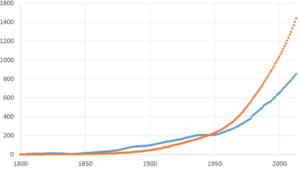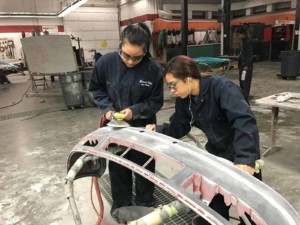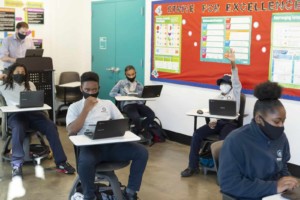COVID-19: Motivation for an Altered Mindset

Education systems and societies at large are arguably fragile. The coronavirus outbreak is case in point, seemingly having an effect of not only forcing school closures but optimistically, perfectly positioning education systems to become more resilient and innovative. Or, as Apple campaigned more than two decades ago, to “Think Different.”
Alternative systems for learning are being designed in real-time. This is in response to the nature of schools being inherently “antifragile.” In doing so, trust is surfacing as a necessary element. Trust in these redesigned systems. Trust in the pivotal role we as teachers play. And paramount, trust in our students and that learning, though it may look differently, will continue.
Positively, there is an opportunity for greater transference of responsibility for learning. Transference to and I would argue, also for the learner. Twenty-first-century skills we have talked tirelessly for the past two decades are finally feeling the effects of this “litmus test.” Some educators are likely feeling the test and will benefit from reflection, close examination and hopefully greater communication with colleagues who are not only adapting but excited and also thriving.
Simultaneously, the current situation provides for greater autonomy on the part of teachers and students alike. With this, the all-too-forgotten essential element, student empowerment. Granted, this will mean something drastically different across age groups. For an eight-year-old, online learning may, in the end, result in improved reading habits. Whereas, for a middle-level learner, he or she may acquire more self-discipline or possibly better his or her communication skills.
Education, a Multi-Headed Beast
Nassim Taleb, the author behind the word “antifragile” wrote, “complex systems are weakened, even killed, when deprived of stressors.” Education today, with all of its pushes and pulls, often feels like a mythological beast. Befitting, as the classic example of antifragile, is Hydra. As you may remember, the serpentine water monster had numerous heads and when one was cut off, two would grow back in its place. Talk about resilience! Resilience, in effect, speaks to the need to adapt in the face of change. Even when your head is cut off. Thankfully this isn’t our case. We are just being challenged to redefine education and tool-up so we might be more effective digitally.
All the while, coronavirus and its scariness might create even more terror than if we were to run into Hydra at the local coffee shop. A byline of a New York Times article on March 5, 2020, reported how the United Nations said, “The global scale and speed of the educational disruption from the coronavirus epidemic is unparalleled.” The cases of people testing positive for COV-19 continue to rise across the globe and recent news in the United States alone reports how more than 100 universities have canceled in-person classes. On the list are the likes of Columbia, Stanford, and Princeton. Education is undergoing a field test for what digital learning might look like. And arguably, the end does not appear to be in sight.
In the February edition of The Atlantic, author James Hamblin wrote an article grimly titled, “You’re Likely to Get the Coronavirus.” Hamblin imparts, “The Harvard epidemiology professor Marc Lipsitch…predicts that within the coming year, some 40 to 70 percent of people around the world will be infected with the virus that causes COVID-19.”
The Show Goes On, It Must!
So, as more schools, districts, states, and even countries take the plunge in digital learning, any surface tension already is broken. In accordance with Moore’s Law and the speed and capability of technology, educators, too, are moving fast. The COVID-19 pandemic has created a volatile scenario enabling educators to make rapid changes to their teaching. For example, thought experiments like distinguished professor Yong Zhao’s prompts discussion and the sharing of ideas relative to the question, “What If Schools Are Closed for More than a Year Due to the New Coronavirus (COVID-19)?” Meanwhile, a Facebook group titled “Educator Temporary School Closure for Online Learning” was created the last days of February and in less than three weeks over 95,000 educators joined across the globe. So, teachers are connecting and optimizing the situation as a means for improving as professionals, but also showcasing how learning no longer fits in perfect rows of desks, contained within four walls. Learning can happen everywhere. Moreover, it DOES happen everywhere!
Case in Point
Digital and home learning are not exactly in their infancy. In 2014, Forbes reported how the United States already had 2.7 million K-12 students enrolled in online learning programs. Urban and rural areas both, as well as the far edges of the Earth, have engaged in digital learning for years. Until now, it largely was a result of remoteness, academic reasons, and other factors such as greater flexibility in schedule. One big difference now is that so many families are currently having the choice made for them. It is an opportune time to build our compassion for the myriad having the choice made for them. A positive, however, is that families might, as a result, become even more involved in the curriculum and their child’s experience as a learner.
Set Aside Those Screens
Finally, societies seemingly continue to move further away from an understanding of how nature nurtures. In effect, the role of curiosity has declined. Moreover, the standardization of the curriculum leads to a little wiggle room or even time to posit. Many schools have, in effect, become “To Do Tanks” as opposed to “Think Tanks” or living laboratories, with so much structure that it proves to be deleterious.
Pivotal to the success of digital learning will be the virtue of balance. In this, monitoring but also managing screen time is of absolute importance. The Washington Post reported in October 2019 that Common Sense Media, a nonprofit that tracks young people’s tech habits, found that American teens spend on average more than seven hours online daily. Further, this did not include time spent using screens for school or homework.
Humans as a species ascended through indefatigable curiosity. Curiosity innate in play.
Possibly more than ever before in history, this priority to play should ring from every village and every hamlet. Set aside those screens and get outside! However, not before you put on your face mask!
For more, see:
- Podcast: Kristi Dominguez & Ellen Doer: Leading Central Systems Through COVID-19 with Optimism, Hope and Love
- The Growing Need for Online Teachers
- Getting Through: Leading Through and to a New Generation of Learning Systems
Stay in-the-know with innovations in learning by signing up for the weekly Smart Update.
Matt Piercy works at the International School Bangkok. You can follow him on Twitter @mpiercy35.






0 Comments
Leave a Comment
Your email address will not be published. All fields are required.